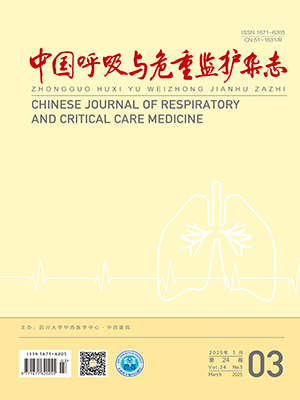Objective To study the pathology and possible mechanism of experimental hydrochloric acid(HCl) inhalation-indued pulmonary fibrosis in rats.Methods 120 male SD rats were randomly divided into a nomal control group,a bleomycin group,a high dose HCl group,a middle dose HCl group and a low dose HCl group.The bleomycin group was intratracheally injected with bleomycin once to induce pulmonary fibrosis.The three HCl groups were intratracheally injected with HCl once per week.The control group was given saline by the same way.Six rats of each group were randomly sacrificed on day 7,14,28 and 42 respectively.The histological changes of lung tissue were studied by HE and Masson’s trichrome staining.Hydroxyproline level in lung tissue was measured by digestion method.Protein and mRNA expression of transforming growth factor-β1(TGF-β1) were assayed by immunohistochemistry and RT-PCR respectively.Results Alveolitis in three HCl groups was significantl compared to control group,most severe at the second week,then remained at a high level which was equivalent to or exceeded the level of the bleomysin group after 28 days.Pulmonary fibrosis in three HCl groups was also significantly more severe than that in the control group,but milder than that in the bleomysin group.The high-dose and middle-dose HCl groups were not significantly different from the bleomysin group on day 42.There was no difference between three HCl groups in the earlier period,but the high-dose HCl group has a significantly difference from low-dose group on day 42.The content of hydroxyproline in high-dose and middle-dose HCl groups was also significantly higher than that in the control group.On day 42 hydroxyproline content in high-dose HCl dose rather middle –or low dose group was similiar with the level of bleomysin group.Content of TGF-β1 mRNA in three HCl groups was comparable to the level of bleomysin group on day 28 and exceeded on day 42.The expression of TGF-β1 in three HCl groups was not significantly different from the bleomysin group on day 42.Conclusion Experimental acid aspiration might contribute to pulmonary fibrosis in rats.Acid induced alveolar epithelial cell damage,abnormal proliferation and repair and fibrosis could be involved..
Citation:
CHEN Shi,ZHANG Deping. A pilot study of acid inhalation-induced pulmonary fibrosis in rats. Chinese Journal of Respiratory and Critical Care Medicine, 2008, 08(5): 370-375. doi:
Copy
Copyright © the editorial department of Chinese Journal of Respiratory and Critical Care Medicine of West China Medical Publisher. All rights reserved
| 1. |
Salvioli B,Belmonte G,Stanghellini V,et al.Gastro-oesophageal reflux and interstitial lung disease.Dig Liver Dis,2006,38:879-884.
|
| 2. |
Raghu G,Freudenberger TD,Yang S,et al.High prevalence of abnormal acid gastro-oesophageal reflux in idiopathic pulmonary fibrosis.Eur Respir J,2006,27:136-142.
|
| 3. |
Szapiel SV,Elson NA,Fulmer JD,et a1.Bleomycin-induced interstitial pulmonary disease in the nude,athymic mouse.Am Rev Resp Dis,1979,120:893-899.
|
| 4. |
Hawryłkiewicz I,Pływaczewski R,Dziedzic D,et al.Gastroesophageal reflux disease(GERD) in patients with obstructive sleep apnoea syndrome(OSAS).Pneumonol Alergol Pol,2006,74:361-364.
|
| 5. |
Weldon DR.Gastroesophageal reflux disease and sinusitis:their role in patients with chronic cough.Allergy Asthma Proc,2006,27:36-44.
|
| 6. |
Havemann BD,Henderson CA,El-Serag HB.The association between gastro-oesophageal reflux disease and asthma:a systematic review.Gut,2007,56:1654-1664.
|
| 7. |
Kempainen RR,Savik K,Whelan TP,et al.High prevalence of proximal and distal gastroesophageal reflux disease in advanced COPD.Chest,2007,131:1666-1671.
|
| 8. |
王萍,秦雪冰,王瑞娟,等.胃食管反流与慢性阻塞性肺疾病急性加重的关系探讨.中国呼吸与危重监护杂志,2007,6:177-179,193.
|
| 9. |
Mays EE,Dubois JJ,Hamilton GB.Pulmonary fibrosis associated with tracheobronchial aspiration:a study of the frequency of hiatal hernia and gastroesophageal reflux in interstitial pulmonary fibrosis of obscure etiology.Chest,1976,69:512-515.
|
| 10. |
Selman M,Pardo A.Role of epithelial cells in idiopathic pulmonary fibrosis:from innocent targets to serial killers.Proc Am Thorac Soc,2006,3:364-372.
|
| 11. |
Popper H,Juettner F,Pinter J.The gastric juice aspiration syndrome(Mendelson syndrome).Aspects of pathogenesis and treatment in the pig.Virchows Arch A Pathol Anat Histopathol,1986,409:105-117.
|
| 12. |
张德平,庄谊,孟凡青,等.γ干扰素对实验性肺纤维化大鼠肺泡炎和肺纤维化的影响.中国呼吸与危重监护杂志,2006,5:189-192.
|
| 13. |
柴文戍,李永春,刘玉玲,等.博莱霉素致肺纤维化大鼠形态学变化的实验研究.中国实验动物学报,2003,11,77-80.
|
| 14. |
Bartram U,Speer CP.The role of transforming growth factor beta in lung development and disease.Chest,2004,125:754-765.
|
| 15. |
Allen JT,Spiteri MA.Growth factors in idiopathic pulmonary fibrosis:relative roles.Respir Res,2002,3:13-16.
|
- 1. Salvioli B,Belmonte G,Stanghellini V,et al.Gastro-oesophageal reflux and interstitial lung disease.Dig Liver Dis,2006,38:879-884.
- 2. Raghu G,Freudenberger TD,Yang S,et al.High prevalence of abnormal acid gastro-oesophageal reflux in idiopathic pulmonary fibrosis.Eur Respir J,2006,27:136-142.
- 3. Szapiel SV,Elson NA,Fulmer JD,et a1.Bleomycin-induced interstitial pulmonary disease in the nude,athymic mouse.Am Rev Resp Dis,1979,120:893-899.
- 4. Hawryłkiewicz I,Pływaczewski R,Dziedzic D,et al.Gastroesophageal reflux disease(GERD) in patients with obstructive sleep apnoea syndrome(OSAS).Pneumonol Alergol Pol,2006,74:361-364.
- 5. Weldon DR.Gastroesophageal reflux disease and sinusitis:their role in patients with chronic cough.Allergy Asthma Proc,2006,27:36-44.
- 6. Havemann BD,Henderson CA,El-Serag HB.The association between gastro-oesophageal reflux disease and asthma:a systematic review.Gut,2007,56:1654-1664.
- 7. Kempainen RR,Savik K,Whelan TP,et al.High prevalence of proximal and distal gastroesophageal reflux disease in advanced COPD.Chest,2007,131:1666-1671.
- 8. 王萍,秦雪冰,王瑞娟,等.胃食管反流与慢性阻塞性肺疾病急性加重的关系探讨.中国呼吸与危重监护杂志,2007,6:177-179,193.
- 9. Mays EE,Dubois JJ,Hamilton GB.Pulmonary fibrosis associated with tracheobronchial aspiration:a study of the frequency of hiatal hernia and gastroesophageal reflux in interstitial pulmonary fibrosis of obscure etiology.Chest,1976,69:512-515.
- 10. Selman M,Pardo A.Role of epithelial cells in idiopathic pulmonary fibrosis:from innocent targets to serial killers.Proc Am Thorac Soc,2006,3:364-372.
- 11. Popper H,Juettner F,Pinter J.The gastric juice aspiration syndrome(Mendelson syndrome).Aspects of pathogenesis and treatment in the pig.Virchows Arch A Pathol Anat Histopathol,1986,409:105-117.
- 12. 张德平,庄谊,孟凡青,等.γ干扰素对实验性肺纤维化大鼠肺泡炎和肺纤维化的影响.中国呼吸与危重监护杂志,2006,5:189-192.
- 13. 柴文戍,李永春,刘玉玲,等.博莱霉素致肺纤维化大鼠形态学变化的实验研究.中国实验动物学报,2003,11,77-80.
- 14. Bartram U,Speer CP.The role of transforming growth factor beta in lung development and disease.Chest,2004,125:754-765.
- 15. Allen JT,Spiteri MA.Growth factors in idiopathic pulmonary fibrosis:relative roles.Respir Res,2002,3:13-16.




